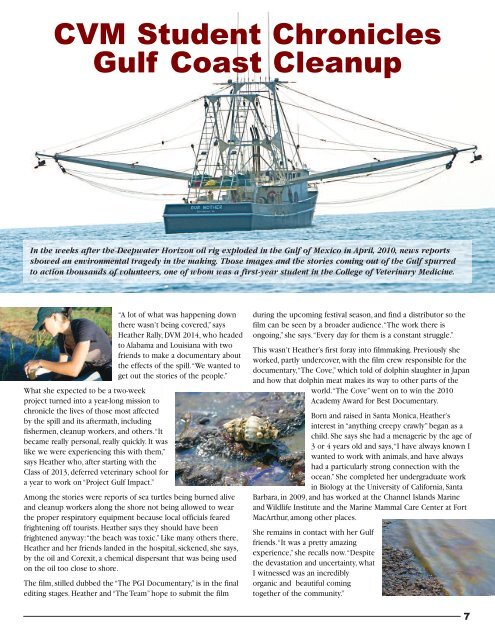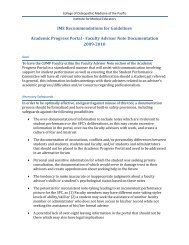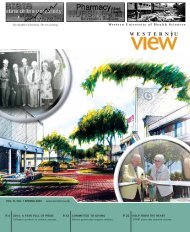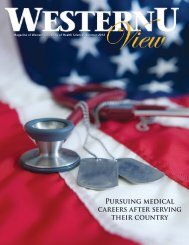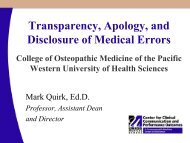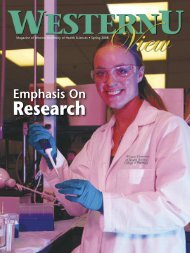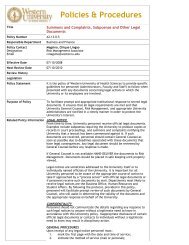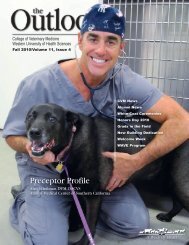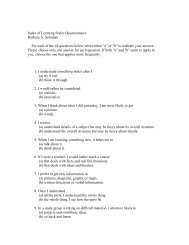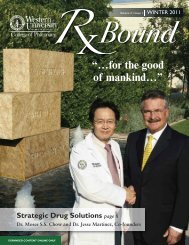The Outlook - Western University of Health Sciences
The Outlook - Western University of Health Sciences
The Outlook - Western University of Health Sciences
- No tags were found...
You also want an ePaper? Increase the reach of your titles
YUMPU automatically turns print PDFs into web optimized ePapers that Google loves.
CVM Student ChroniclesGulf Coast CleanupIn the weeks after the Deepwater Horizon oil rig exploded in the Gulf <strong>of</strong> Mexico in April, 2010, news reportsshowed an environmental tragedy in the making. Those images and the stories coming out <strong>of</strong> the Gulf spurredto action thousands <strong>of</strong> volunteers, one <strong>of</strong> whom was a first-year student in the College <strong>of</strong> Veterinary Medicine.“A lot <strong>of</strong> what was happening downthere wasn’t being covered,” saysHeather Rally, DVM 2014, who headedto Alabama and Louisiana with tw<strong>of</strong>riends to make a documentary aboutthe effects <strong>of</strong> the spill. “We wanted toget out the stories <strong>of</strong> the people.”What she expected to be a two-weekproject turned into a year-long mission tochronicle the lives <strong>of</strong> those most affectedby the spill and its aftermath, includingfishermen, cleanup workers, and others. “Itbecame really personal, really quickly. It waslike we were experiencing this with them,”says Heather who, after starting with theClass <strong>of</strong> 2013, deferred veterinary school fora year to work on “Project Gulf Impact.”Among the stories were reports <strong>of</strong> sea turtles being burned aliveand cleanup workers along the shore not being allowed to wearthe proper respiratory equipment because local <strong>of</strong>ficials fearedfrightening <strong>of</strong>f tourists. Heather says they should have beenfrightened anyway: “the beach was toxic.” Like many others there,Heather and her friends landed in the hospital, sickened, she says,by the oil and Corexit, a chemical dispersant that was being usedon the oil too close to shore.<strong>The</strong> film, stilled dubbed the “<strong>The</strong> PGI Documentary,” is in the finalediting stages. Heather and “<strong>The</strong> Team” hope to submit the filmduring the upcoming festival season, and find a distributor so thefilm can be seen by a broader audience. “<strong>The</strong> work there isongoing,” she says. “Every day for them is a constant struggle.”This wasn’t Heather’s first foray into filmmaking. Previously sheworked, partly undercover, with the film crew responsible for thedocumentary, “<strong>The</strong> Cove,” which told <strong>of</strong> dolphin slaughter in Japanand how that dolphin meat makes its way to other parts <strong>of</strong> theworld. “<strong>The</strong> Cove” went on to win the 2010Academy Award for Best Documentary.Born and raised in Santa Monica, Heather’sinterest in “anything creepy crawly” began as achild. She says she had a menagerie by the age <strong>of</strong>3 or 4 years old and says, “I have always known Iwanted to work with animals, and have alwayshad a particularly strong connection with theocean.” She completed her undergraduate workin Biology at the <strong>University</strong> <strong>of</strong> California, SantaBarbara, in 2009, and has worked at the Channel Islands Marineand Wildlife Institute and the Marine Mammal Care Center at FortMacArthur, among other places.She remains in contact with her Gulffriends. “It was a pretty amazingexperience,” she recalls now. “Despitethe devastation and uncertainty, whatI witnessed was an incrediblyorganic and beautiful comingtogether <strong>of</strong> the community.”7


